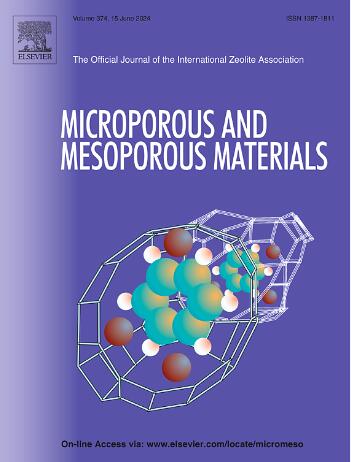Tailoring the preparation of USY zeolite with uniform mesoporosity for improved catalytic activity in phenol/isopropanol alkylation
IF 4.8
3区 材料科学
Q1 CHEMISTRY, APPLIED
引用次数: 0
Abstract
The preparation of hierarchical USY zeolite, exhibiting uniform mesoporosity and high Si/Al atomic ratio (48–52), has been investigated by means of a surfactant/ammonia post-treatment applied to a commercial USY sample. The procedure involved the use of temperatures within 40–135 °C, a low ammonia concentration solution (0.05 N) and hydrothermal synthesis times of 20 h. When working at 40–80 °C, the obtained USY samples exhibit enhanced intraparticular mesoporosity (324–418 m2 g−1), showing increasingly uniform mesopores around 4.0 nm, while holding a remarkable zeolitic microporosity (413–363 m2 g−1). In contrast, higher temperatures resulted in a steady abatement of crystalline zeolitic domains, with a total collapse of the zeolite structure at 135 °C. These hierarchical USY materials were tested in the alkylation of phenol with isopropanol, wherein one of the obtained products, e.g. 2,6-diisopropylphenol (Propofol), is the most important intravenous anaesthetic in the market. Interestingly, the generation of the uniform mesoporosity in USY samples led to an enhancement of both the phenol conversion and the selectivity towards C-alkylation products. Thus, the sample treated at 60 °C (USY-60) gave rise to the highest selectivity towards C-alkylation products (84 %) and poly-alkylphenols formation (72 %), with an encouraging selectivity towards 2,6-diisopropylphenol (43 %).

为提高苯酚/异丙醇烷基化的催化活性,定制均匀介孔USY分子筛的制备
采用表面活性剂/氨后处理的方法,制备了具有均匀介孔和高Si/Al原子比(48-52)的多级USY沸石。该过程涉及使用温度在40-135℃,低氨浓度溶液(0.05 N)和水热合成时间为20 h。当工作在40-80℃时,所获得的USY样品显示出增强的颗粒内介孔(324-418 m2 g−1),在4.0 nm附近显示出越来越均匀的介孔,同时保持显着的沸石微孔(413-363 m2 g−1)。相反,较高的温度导致结晶沸石域的稳定减少,沸石结构在135℃时完全崩溃。这些分层USY材料在苯酚与异丙醇的烷基化反应中进行了测试,其中获得的产品之一,例如2,6-二异丙酚(异丙酚),是市场上最重要的静脉麻醉剂。有趣的是,USY样品中均匀介孔的产生导致了苯酚转化率和对c -烷基化产物的选择性的增强。因此,在60°C (USY-60)下处理的样品对C-烷基化产物(84%)和聚烷基酚形成(72%)产生了最高的选择性,对2,6-二异丙基苯酚的选择性令人鼓舞(43%)。
本文章由计算机程序翻译,如有差异,请以英文原文为准。
求助全文
约1分钟内获得全文
求助全文
来源期刊

Microporous and Mesoporous Materials
化学-材料科学:综合
CiteScore
10.70
自引率
5.80%
发文量
649
审稿时长
26 days
期刊介绍:
Microporous and Mesoporous Materials covers novel and significant aspects of porous solids classified as either microporous (pore size up to 2 nm) or mesoporous (pore size 2 to 50 nm). The porosity should have a specific impact on the material properties or application. Typical examples are zeolites and zeolite-like materials, pillared materials, clathrasils and clathrates, carbon molecular sieves, ordered mesoporous materials, organic/inorganic porous hybrid materials, or porous metal oxides. Both natural and synthetic porous materials are within the scope of the journal.
Topics which are particularly of interest include:
All aspects of natural microporous and mesoporous solids
The synthesis of crystalline or amorphous porous materials
The physico-chemical characterization of microporous and mesoporous solids, especially spectroscopic and microscopic
The modification of microporous and mesoporous solids, for example by ion exchange or solid-state reactions
All topics related to diffusion of mobile species in the pores of microporous and mesoporous materials
Adsorption (and other separation techniques) using microporous or mesoporous adsorbents
Catalysis by microporous and mesoporous materials
Host/guest interactions
Theoretical chemistry and modelling of host/guest interactions
All topics related to the application of microporous and mesoporous materials in industrial catalysis, separation technology, environmental protection, electrochemistry, membranes, sensors, optical devices, etc.
 求助内容:
求助内容: 应助结果提醒方式:
应助结果提醒方式:


